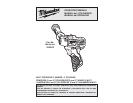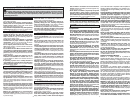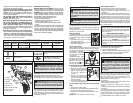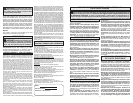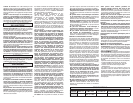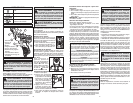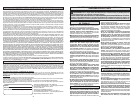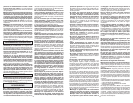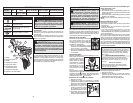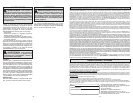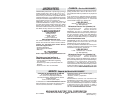
2
3
tions. The dust mask or respirator must be capable of
fi ltrating particles generated by your operation. Pro-
longed exposure to high intensity noise may cause
hearing loss.
• Keep bystanders a safe distance away from work
area. Anyone entering the work area must wear
personal protective equipment. Fragments of
workpiece or of a broken accessory may fl y away and
cause injury beyond immediate area of operation.
• Hold the power tool by insulated gripping sur-
faces only, when performing an operation where
the cutting accessory may contact hidden wiring.
Contact with a “live” wire will also make exposed
metal parts of the power tool “live” and could give the
operator an electric shock.
• Position the cord clear of the spinning accessory.
If you lose control, the cord may be cut or snagged
and your hand or arm may be pulled in to the spin-
ning accessory.
• Never lay the power tool down until the acces-
sory has come to a complete stop. The spinning
accessory may grab the surface and pull the power
tool out of your control.
• Do not run the power tool while carrying it at your
side. Accidental contact with the spinning accessory
could snag your clothing, pulling the accessory into
your body.
• Regularly clean the power tool’s air vents. The
motor’s fan will draw the dust inside the housing
and excessive accumulation of powdered metal may
cause electrical hazards.
• Do not operate the power tool near fl ammable
materials. Sparks could ignite these materials.
• Do not use accessories that require liquid cool-
ants. Using water or other liquid coolants may result
in electrocution or shock.
Kickback and Related Warnings
Kickback is a sudden reaction to a pinched or
snagged rotating wheel, backing pad, brush or any
other accessory. Pinching or snagging causes rapid
stalling of the rotating accessory which in turn causes
the uncontrolled power tool to be forced in the direc-
tion opposite of the accessory’s rotation at the point
of the binding.
For example, if an abrasive wheel is snagged or
pinched by the workpiece, the edge of the wheel that
is entering into the pinch point can dig into the surface
of the material causing the wheel to climb out or kick
out. The wheel may either jump toward or away from
the operator, depending on direction of the wheel’s
movement at the point of pinching. Abrasive wheels
may also break under these conditions.
Kickback is the result of power tool misuse and/or in-
correct operating procedures or conditions and can be
avoided by taking proper precautions as given below.
• Maintain a fi rm grip on the power tool and po-
sition your body and arm to allow you to resist
kickback forces. Always use auxiliary handle, if
provided, for maximum control over kickback or
torque reaction during start-up. The operator can
control torque reactions or kickback forces, if proper
precautions are taken.
• Never place your hand near the rotating acces-
sory. Accessory may kickback over your hand.
• Do not position your body in the area where pow-
er tool will move if kickback occurs. Kickback will
Safety Warnings Common for Sanding and Polish-
ing Operations:
• This power tool is intended to function as a sand-
er or polisher. Read all safety warnings, instruc-
tions, illustr ations and specifi cations provided
with this power tool. Failure to follow all instructions
listed below may result in electric shock, fi re and/or
serious injury
.
• Operations such as grinding, wire brushing
or cutting-off are not recommended to be per-
formed with this power tool. Operations for which
the power tool was not designed may create a haz-
ard and cause personal injury.
• Do not use accessories which are not specifi -
cally designed and recommended by the tool
manufacturer. Just because the accessory can be
attached to your power tool, it does not assure safe
operation.
• The rated speed of the accessory must be at least
equal to the maximum speed marked on the pow-
er tool. Accessories running faster than their RATED
SPEED can break and fl y apart.
• The outside diameter and the thickness of your
accessory must be within the capacity rating of
your power tool. Incorrectly sized accessories can-
not be adequately guarded or controlled.
• The arbour size of wheels, fl anges, backing pads
or any other accessory must properly fi t the
spindle of the power tool. Accessories with arbour
holes that do not match the mounting hardware of the
power tool will run out of balance, vibrate excessively
and may cause loss of control.
• Do not use a damaged accessory. Before each
use inspect the accessory such as abrasive
wheels for chips and cracks, backing pad for
cracks, tear or excess wear, wire brush for loose
or cracked wires. If power tool or accessory is
dropped, inspect for damage or install an undam-
aged accessory. After inspecting and installing
an accessory, position yourself and bystand-
ers away from the plane of the rotating acces-
sory and run the power tool at maximum no-load
speed for one minute. Damaged accessories will
normally break apart during this test time.
• Wear personal protective equipment. Depending
on application, use face shield, safety goggles or
safety glasses. As appropriate, wear dust mask,
hearing protectors, gloves and workshop apron
capable of stopping small abrasive or workpiece
fragments. The eye protection must be capable of
stopping fl ying debris generated by various opera-
BATTERY TOOL USE AND CARE
SPECIFIC SAFETY RULES
PERSONAL SAFETY
GENERAL POWER TOOL SAFETY WARNINGS
WORK AREA SAFETY
ELECTRICAL SAFETY
• Keep work area clean and well lit. Cluttered or dark
areas invite accidents.
• Do not operate power tools in explosive atmos-
pheres, such as in the presence of fl ammable
liquids, gases or dust. Power tools create sparks
which may ignite the dust or fumes.
• Keep children and bystanders away while operating
a power tool. Distractions can cause you to lose control.
• Power tool plugs must match the outlet. Never
modify the plug in any way. Do not use any
adapter plugs with earthed (grounded) power
tools. Unmodifi ed plugs and matching outlets will
reduce risk of electric shock.
• Avoid body contact with earthed or grounded
surfaces such as pipes, radiators, ranges and
refrigerators. There is an increased risk of electric
shock if your body is earthed or grounded.
• Do not expose power tools to rain or wet condi-
tions. Water entering a power tool will increase the
risk of electric shock.
• Do not abuse the cord. Never use the cord for car-
rying, pulling or unplugging the power tool. Keep
cord away from heat, oil, sharp edges or moving
parts. Damaged or entangled cords increase the risk
of electric shock.
• When operating a power tool outdoors, use an
extension cord suitable for outdoor use. Use of
a cord suitable for outdoor use reduces the risk of
electric shock.
• If operating a power tool in a damp location is
unavoidable, use a ground fault circuit interrupter
(GFCI) protected supply. Use of an GFCI reduces
the risk of electric shock.
• Do not overreach. Keep proper footing and bal-
ance at all times. This enables better control of the
power tool in unexpected situations.
• Dress properly. Do not wear loose clothing or
jewellery. Keep your hair, clothing and gloves
away from moving parts. Loose clothes, jewellery
or long hair can be caught in moving parts.
• If devices are provided for the connection of dust
extraction and collection facilities, ensure these
are connected and properly used. Use of dust col-
lection can reduce dust-related hazards.
WARNING READ ALL SAFETY WARNINGS AND ALL INSTRUCTIONS. Failure
to follow the warnings and instructions may result in electric shock, fi re and/or serious
injury. Save all warnings and instructions for future reference. The term "power
tool" in the warnings refers to your mains-operated (corded) power tool or battery-operated
(cordless) power tool.
POWER TOOL USE AND CARE
• Do not force the power tool. Use the correct power
tool for your application. The correct power tool will
do the job better and safer at the rate for which it was
designed.
• Do not use the power tool if the switch does not
turn it on and off. Any power tool that cannot be
controlled with the switch is dangerous and must be
repaired.
• Disconnect the plug from the power source and/
or the battery pack from the power tool before
making any adjustments, changing accessories,
or storing power tools. Such preventive safety
measures reduce the risk of starting the power tool
accidentally.
• Store idle power tools out of the reach of children
and do not allow persons unfamiliar with the
power tool or these instructions to operate the
power tool. Power tools are dangerous in the hands
of untrained users.
• Maintain power tools. Check for misalignment or
binding of moving parts, breakage of parts and
any other condition that may affect the power
tool’s operation. If damaged, have the power tool
repaired before use. Many accidents are caused by
poorly maintained power tools.
• Keep cutting tools sharp and clean. Properly main-
tained cutting tools with sharp cutting edges are less
likely to bind and are easier to control.
• Use the power tool, accessories and tool bits etc.
in accordance with these instructions, taking into
account the working conditions and the work to
be performed. Use of the power tool for operations
different from those intended could result in a hazard-
ous situation.
• Stay alert, watch what you are doing and use
common sense when operating a power tool. Do
not use a power tool while you are tired or under
the infl uence of drugs, alcohol or medication. A
moment of inattention while operating power tools
may result in serious personal injury.
• Use personal protective equipment. Always wear
eye protection. Protective equipment such as dust
mask, non-skid safety shoes, hard hat, or hearing
protection used for appropriate conditions will reduce
personal injuries.
• Prevent unintentional starting. Ensure the switch
is in the off-position before connecting to power
source and/or battery pack, picking up or carrying
the tool. Carrying power tools with your fi nger on the
switch or energising power tools that have the switch
on invites accidents.
• Remove any adjusting key or wrench before
turning the power tool on. A wrench or a key left
attached to a rotating part of the power tool may result
in personal injury.
SERVICE
• Recharge only with the charger specifi ed by the
manufacturer. A charger that is suitable for one type
of battery pack may create a risk of fi re when used
with another battery pack.
• Use power tools only with specifi cally designated
battery packs. Use of any other battery packs may
create a risk of injury and fi re.
• When battery pack is not in use, keep it away
from other metal objects like paper clips, coins,
keys, nails, screws, or other small metal objects
that can make a connection from one terminal to
another. Shorting the battery terminals together may
cause burns or a fi re.
• Under abusive conditions, liquid may be ejected
from the battery; avoid contact. If contact acci-
dentally occurs, fl ush with water. If liquid contacts
eyes, additionally seek medical help. Liquid ejected
from the battery may cause irritation or burns.
• Have your power tool serviced by a qualifi ed repair
person using only identical replacement parts.
This will ensure that the safety of the power tool is
maintained.



